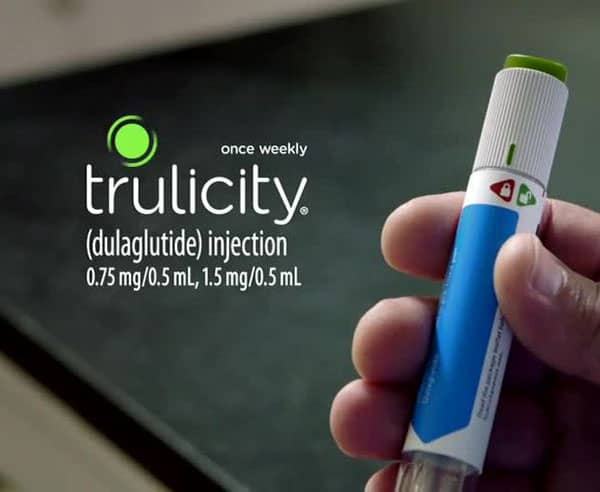
Living with type 2 diabetes can be challenging. With the changes to your lifestyle, your diet and how you schedule your days, can sometimes seem like the weight of the world is on your shoulders.
The FDA approved Lilly’s Once weekly Trulicity injection for those with Type 2 diabetes in 2014 and it’s slowly becoming a go to treatment for those with type 2 diabetes in combination with other medications.
But some are concerned it’s not as great as it is made out to be.
What Is Trulicity?
Trulicity is a non-insulin injection for those with Type 2 diabetes. Type 2 diabetes is the most common diabetes form. In fact, according to the Centers for Disease Control, roughly 29.1 million adults in the U.S. have diabetes. Of that number, between 90% and 95% have Type 2 diabetes.
Trulicity, also known as Dulaglutide, is from Eli Lilly and Company. The drug is in a pharmacologic class of medications known as GLP-1 receptor agonists. The Food and Drug Administration (FDA) approved the use of Trulicity in September of 2014 and the Eli Lilly and Company released the medication to pharmacies in the U.S. two months later.
There are 2 dosages available for Trulicity: The first is .75 milligrams, where most people start dosing and the other is 1.5 milligrams, which may be increased by your doctor, if needed.
I suggest reading the following:
How Does Trulicity Work?
Trulicity is designed to help your body release insulin, since those who have Type 2 diabetes, their bodies don’t utilize insulin correctly so that normal blood sugar levels can be maintained. Trulicity is not an insulin but is designed to work just like your body’s own GLP-1 hormone. The drug is used along with diet and exercise to manage blood sugar levels.
How Is Trulicity Taken?
Trulicity only needs to be taken once a week, unlike some other GLP-1 drugs that need to be injected daily, like Victoza. Also, it doesn’t need any mixing like other diabetes medications. For instance, Tanzeum and Bydureon must be mixed before using.
Trulicity is injected in either your abdomen, thigh or upper arm. Injections sites should be rotated each week.
If a dose of Trulicity is missed, it should be taken within 3 days of the missed dose. If it has been more than 3 days since the missed dose, the missed dose is not taken and the next weekly dose should be taken as scheduled.
What Are the Side Effects of Trulicity?
As with most medications, there are some side effects from taking Trulicity. The most common side effects include abdominal pain, decreased appetite, diarrhea, fatigue, indigestion, nausea and vomiting. Serious side effects, although rare but have been reported, include anaphylactic (severe allergic reaction), hypoglycemia (low blood sugar), kidney problems and pancreatitis (inflammation of the pancreas).
What Is Everyone Saying About Trulicity?
As with any medication, there are some pros and cons when it comes to Trulicity.
Pros:
- Trulicity manages blood sugar levels very well. It lowers blood sugar levels to where they are supposed to be, thus helping to possibly prevent complications that are sometimes associated with diabetes, including blindness, heart problems and kidney failure.
- It aids in weight loss, although that is not its main purpose. It does this by keeping food in your body for a longer period of time (essentially slowing down the digestion process), thus giving you that full stomach feeling.
- With Trulicity, you don’t need to attach any needles, since the needle is built-in to the injector pen.
- The more that you use Trulicity, which is a non-insulin injectable, your insulin resistance will decrease.
Cons:
- Trulicity can only be used for those with Type 2 diabetes. So, those with Type 1 diabetes cannot use this medication. Trulicity is not recommended for pediatric patients, meaning patients under the age of 18.
- It may cause thyroid cancer. Studies done using rats and mice show that Trulicity causes thyroid cancer. It is not known, however, if the drug causes this condition in humans. Because of the thyroid cancer possibility, the Food and Drug Administration (FDA), imposed that all prescriptions of Trulicity carry a black box warning label. The purpose of this warning label is to warn consumers that evidence concerning the drug, has shown a severe hazard associated with it.
- There are other warning labels also associated with Trulicity, including “May upset stomach,” “Monitor use closely” and “May require lab monitoring.”
Further reading:
What Is the Verdict on Trulicity?
So, what is the bottom line when it comes to Trulicity? For the most part, Trulicity has had positive results.
According to the Trulicity website, a study showed that, regarding people who were prescribed Trulicity, the higher dose of 1.5 milligrams was helpful to 78% of them, while the lower dose of .75 milligrams was helpful to 66% of them.
Here is what a few actual users had to say on drugs.com:
- User Gabryyl, posted on June 14, 2017- “"On week 6. Doing well, was pressing to hard and injections hurt but figured it out. Find I have a bit of stomach ache after injection but 1 Gin-Gin ginger candy and it's fine. Also found I can't eat anything with tomato sauce until a few days later or my stomach hurts."
- User Teresa72, posted on May 31, 2017- “"I've taken 4 shots of this med and it's a wonder drug to me. My fasting sugars used to be 140-200 now numbers are 85-120. I've had zero issues with this med I also take Invokana I'm very pleased"
- User Jag55, posted on May 16, 2017- “I am on my twelfth day of Trulicity. Mild headaches, curbed appetite, little stomach cramps is the most symptoms I have had. Sugar levels are good."
Trulicity has received high praise from Dr. Laura Fernandez, Lilly Diabetes’ Senior Medical Adviser. She told Chain Drug Review, “Some adults with type 2 diabetes find that diet, exercise and oral medicines aren’t enough to meet their treatment goals. Trulicity may be an option for them as it has demonstrated proven glycemic control, only has to be taken once weekly, and comes in an easy-to-use pen." Share your thoughts and comments down below!
TheDiabetesCouncil Article | Reviewed by Dr. Sergii Vasyliuk MD on May 20, 2020
References:
- https://www.lillyacademy.com/global/_Assets/material/se/Diabetes/Trulicity/SEDUA00097_Till_dig_som_far_Trulicity_ENGELSKA.pdf
- http://www.rxlist.com/trulicity-side-effects-drug-center.htm
- http://www.healthcentral.com/slideshow/must-know-facts-about-non-insulin-injectables?ic=more#slide=1
- http://www.medicinenet.com/trulicity_dulaglutide/article.htm
- https://www.trulicity.com/about-trulicity.html




